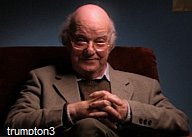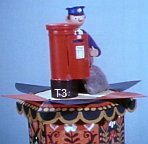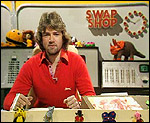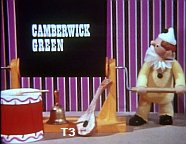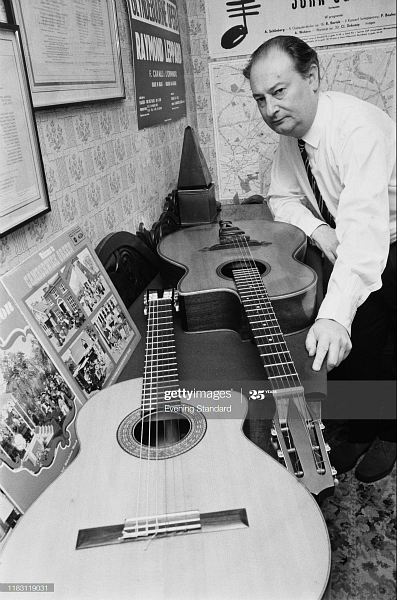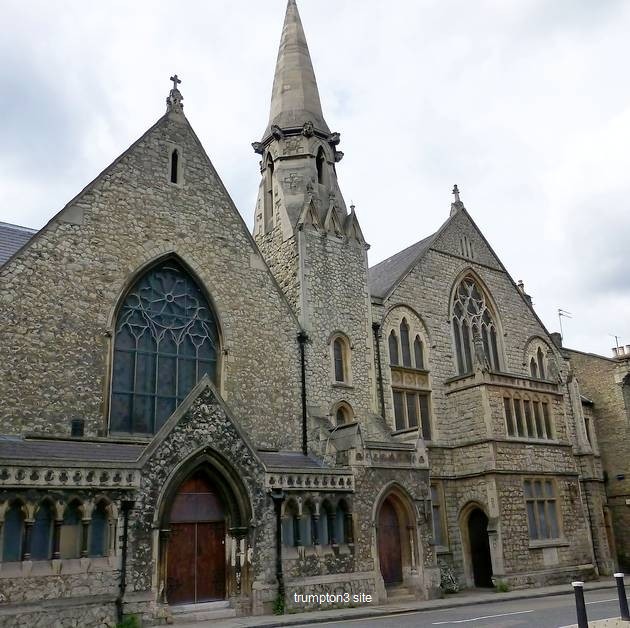 | ||||
The Filming of ....
* Location
The filming was done in a disused church situated in Crouch Hill,London. ( pic above )
Bura & Hardwick later part-leased it to "The Eurythmics" pop music duo of Dave Stewart and Annie Lennox,
who completed their debut "Sweet Dreams" album there in the early 80's before later buying the whole freehold.
They then sold it to singer/songwriter David Gray in 2004,who recorded all his first few albums there.
And it's now owned by music producer Paul Epworth [wiki] - who discusses it all in an interesting youtube video here
* Filming technique
All 3 series were made using stop motion model animation,and actual 3D scaled down models.
The characters were about 6" tall.
They had very simple aluminium wire skeletons to make them sufficiently rigid yet pliable.With ping pong balls for the heads,and clothing made predominantly out of foam latex.
None of them were given mouths,as lip movements were too time consuming (costly) to film.
So the idea of speech is simply reinforced by all the usual body language that accompanies it,with plenty of arm and head movements,as well as basic nods and waves in response to direct questions from the narrator.
That said,in Camberwick there were some instances of open mouths suddenly appearing in a fixed position to reinforce an exclamation.Although even this very minor add-on was subsequently dropped for Trumpton and Chigley.
And each 15 minute episode still took around 4 weeks to film even allowing for the re-use of stock footage.
Which is not surprising when you consider that 25 still photos produced just 1 second of footage.
In addition to the little filming montage below,I've also included a photo from Bob Bura's personal collection.
Taken in 1966 during the filming of Trumpton.And a bonus mark if you know which episode. Pic here
Camberwick Green, Trumpton and Chigley
* The first broadcast dates
Camberwick - 3rd January,1966. Trumpton - 3rd January,1967. Chigley - 6th October,1969.
Each series had 13 episodes of 15 minutes duration.
* Original scheduling
All 39 episodes were 1st broadcast in the same BBC One 1.30pm " Watch With Mother "
timeslot for pre-school children.
* Black & white versus colour
All 3 series were originally shot in both colour and black & white.
Colour wasn't introduced to BBC1 until the autumn of 1969.
So all of the initial runs of both Camberwick and Trumpton were originally broadcast in black & white.As were the almost continuous repeat showings up until the changeover of course.
Chigley's initial run coincided with the changeover.So some were shown in b&w and some in colour.
And even then,it did require you to pay a fair bit extra for a colour tv license .... and to buy a new colour tv .... and to live in area covered by a colour transmitter.
So the rollout of access,as opposed to transmission,was a far more gradual process.
With many households not seeing any of the 3 series in colour until the early 70's.
* The first episode of Camberwick
Centred around," Peter the Postman " [right]. As he was considered the ideal narrative vehicle
to introduce most of the main locations and cast during the course of his daily round.
It was also the original pilot episode.
And includes some problems with the animation that weren't picked up until after filming.
But were considered unimportant enough not to justify a time-consuming and costly re-shoot.
Most notably heat from the lighting causing issues with the rigidity of plastic foliage during
his walk through a wooded area.
And some other minor technical and continuity issues did continue to crop up throughout all 3 series.
See the "oddballs" page for details.
* Production overview
This was definitely not a big budget production.
It was commissioned by the BBC,who have always had to be particularly mindful of costs simply because of the way they themselves are funded.
So the production team was almost ridiculously small by today's standards,and each individual component was outsourced on a sort of cottage industry basis.
But the proof of the pudding is that we're still talking about the results over half a century later.
* The sets
Designed and made by a husband and wife team,John and Margaret Brownfoot,who's background was in theatrical set design (for big people).But they'd also previously worked with Murray at the BBC.
All the sets were made in their house in Harrow Hill,North London
* The animation
Done by a small team led by Bob Bura and John Hardwick in a disused church in London.
Both of whom were also ex-colleagues of Murray's on various BBC string puppet projects.
But who'd subsequently embraced stop motion animation doing work on adverts and inserts for kids tv programmes.
And they also,famously,went on to work with writer/producer John Ryan on his 3 signature BBC kids series of Mary,Mungo & Midge,Captain Pugwash and The Adventures of Sir Prancelot.
* The songs and sound effects
Every single song and sound effect was composed and performed by classically trained guitarist Freddie Phillips.
All recorded in his London home .... in between frequent interruptions for aircraft noise,because the house
was under the London Airport flight path ( renamed Heathrow the following year )
Following his death,his son,John,now holds all the rights to the music. Photo - 1970 London Evening Standard
And it's the only part of Trumptonshire that Gordon Murray's estate doesn't hold the copyright to.
* The narration and singing
All done by Brian Cant. ie. the only voice you ever hear in all 3 series.
And all recorded at Freddie Phillip's house in Chessington.
Predominantly a theatre actor,he got the job largely off the back of presenting BBC's PlaySchool since it started in 1964.
And he continued to do both PlaySchool and its' offshoot PlayAway until the early 80's.
With his last big tv role coming when he fronted the Channel 5 kids' programme "Dappledown Farm" in the 90's.
Rubovia was shown at lunchtime on BBC1.
And the other 2 were both shown on Noel Edmond's Multi-Coloured Swap Shop,and also featured in its printed annuals.
But all 3 failed to get re-commissioned after their 1st series,and the really tiny amounts of spin-off merchandise they all generated gives a pretty good idea why.
And those were his last tv projects.
Which is a shame.
But his place in tv history had already been assured,and the Trumptonshire merchandise ( sister site ) had also handsomely paid off the mortgage.
So I don't suppose he lost too much sleep over it .... other than maybe nursing a slightly bruised ego.
His last venture before retirement was to start his own publishing company called "Silver Thimble Books" in the 1980's.
Working from home,personally hand-crafting limited edition series of tiny,miniature books -hence the "thimble" reference.
Although it's unclear if it was as much a labour of love as it was a proper business. Pic here
* Where are they now .... people and puppets ?
Unsurprisingly,none of the main players in the production team are still with us sadly.
And the original puppets have proved mortal too.
Unfortunately,foam starts to break down chemically,so the clock was always ticking from day one.
And,when combined with decades of wear 'n' tear,Murray finally decided they'd reached the point of no return
sometime in the mid 1980's and famously cremated them in a back garden bonfire.
Including all the remaining sets too,which is probably slightly harder to justify.
But .... there were at least 2 known survivors :-
# 1. One of the Camberwick "soldier boys" was gifted to a family friend by Murray's daughter Emma in 1986.
He then put it up for sale at a Christies auction in London in May 2003.
But it failed to meet its reserve,with an overly optimistic estimate of £2,000 to £3,000.
And,I believe he still owns it,until someone tells me otherwise.
Pictured,right with another sale item,and fascinating to learn just how big the Thunderbirds puppets were,
bearing in mind that the Camberwick equivalent is far from tiny at about 20-25cm.
# 2. Then a couple of years later,Doctor Mopp also emerged,although his particular escape route isn't documented.
But he too was authenticated by Christies ( I'd love to know how ! ) and included in their Oct.2005 London sale.
Allbeit with practically none of the media coverage the first one got and carrying a much lower estimate of just
£300 to £500.
But at least he found a taker at the bottom end.
Which I reckon was still quite a lot in view of the condition,plus the relative ease with which anyone could build a
suitably distressed replica from scratch and pass it off as original.But see what you think.
* When were the series last shown on the BBC ?
Camberwick on Nov.1st,1985 ,and Trumpton on Nov.29th,1985.
And,for once,Chigley stole the limelight by being the last of the 3 to air on Jan.3rd,1986.
Why the divorce ?
No-one knows for sure.
Maybe the Beeb thought they'd become too old-fashioned and lacked enough social diversity in 1980's Britain ?
But Channel 4 were happy enough to give them a residency from the mid 90's.
And,from 2004 to 2009,they found a home on the kids channel,NickleOdeon Jnr.
After that ? Not sure.But I don't doubt they're still popping up on a channel somewhere if you look hard enough.
And when you add in all the dvd and blu ray releases then there really is no escape !
On this page - all the basic facts and figures about the 3 series
Trumptonshire - The Aftermath
* Why no fourth series ?
Gordon Murray was quoted as saying
"....although I toyed with the idea of a fourth series using a seaside location,I felt the Trumptonshire programmes had run their natural course"
Whether that was true or it was a BBC decision or a combination of the two has never really been established.
But seeing as Chigley was the least popular of the 3 by some distance,then it probably wasn't that hard a decision, whoever actually took it.
And the thought of weaving storylines around a "seaside location" is also somewhat bizarre given the problems the animators faced filming water in the 1st 3 series - all of which is discussed on the "water and fire" page
* Gordon Murray post-Chigley ?
Trumptonshire was a once-in-a-lifetime creation,so it's not surprising that what followed wasn't nearly as successful. Although I can't say "as good",because I haven't actually seen any of them- and how many of us have to be fair ?
But all the following were again made using stop motion. And left to right in the photo montage,below,were ....
1976 - "Rubovia" :- 6 episode remake of a string puppet series he'd made pre-Camberwick whilst still at the BBC.
1977 - "Skip and Fuffy" :- Short 5 minute episodes with the 2 main characters using rhyming wordplay.
1979 - "The Gublin Legends" :-13 episodes featuring bizarre looking monkey-like "people" & more rhyming wordplay.
Gordon Murray and the production team
* The series creator
Gordon Murray 1921 - 2016 ( 2005 photo ).
He worked for the BBC doing children's puppetry.Left to start his own production company,and hit the jackpot with his first attempt -original working title "Candlewick"
He became a stringless animation convert in the process,wrote the scripts and made most of the characters.Although,in the case of Trumpton,he shared writing duties with author Alison Prince [wiki], who is responsible for naming the firemen.
And later went on to create and write another Watch With Mother series called "Joe".
* Stop Motion animation ?
At the end of this paragraph is a link to a short 5 minute youtube video by stop motion legends Aardman Animation.
It gives a very brief idea of the real world,hands-on workings of stop motion as opposed to the completely virtual CGI of Pixar,Disney etc.And may inspire you to delve a bit deeper.
The same basic techniques haven't changed much since Camberwick.
But half a century of technical advancements,and much bigger budgets mean the quality and attention to detail of the finished products are light years apart. Video here

